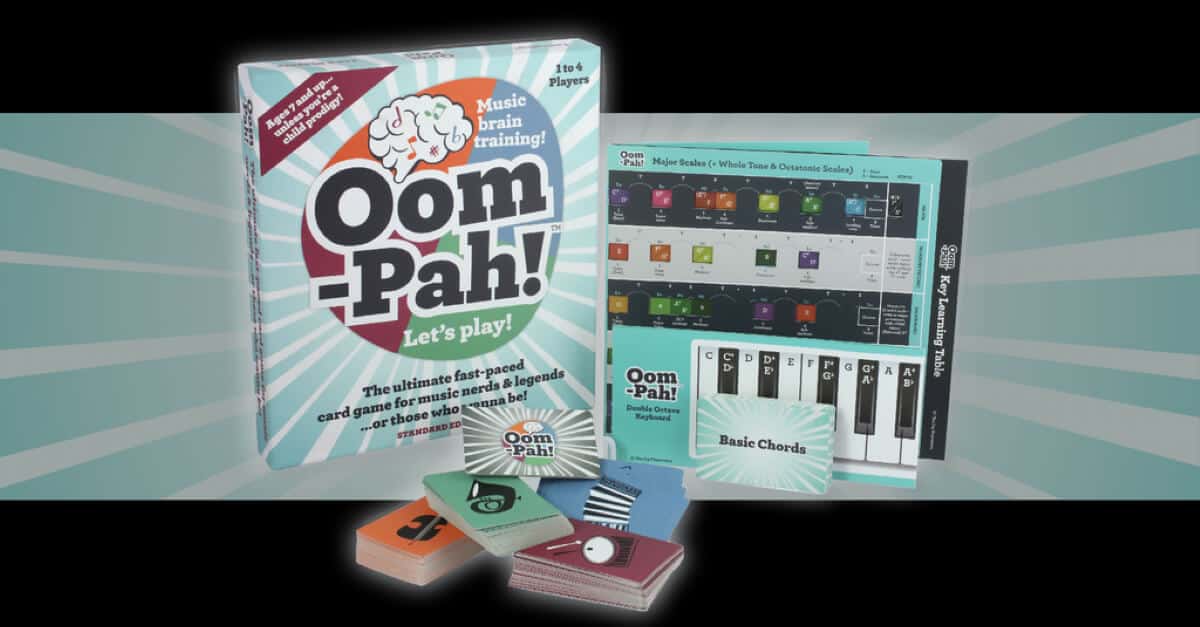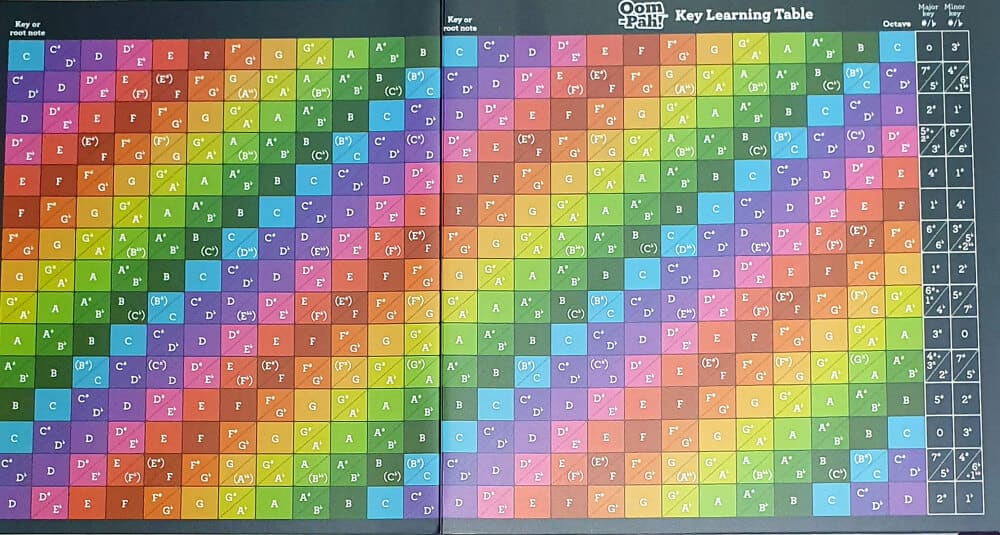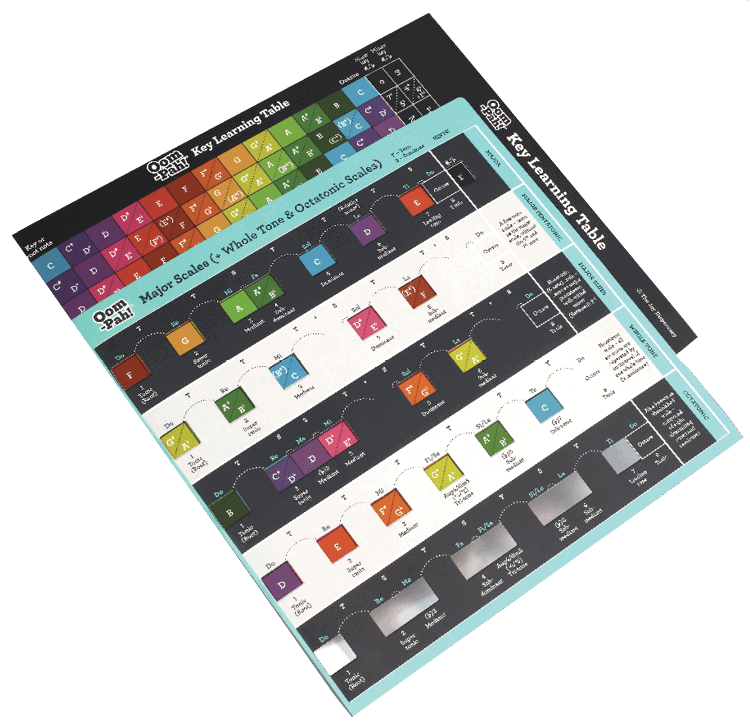
I was lucky enough to sit down with Stace & Liv at PAX Australia in mid-October and to get the opportunity to experience a designers view of their game is always something special.
Oom-Pah!, a musical theory game that was made from amazing knowledge and so much passion. Hearing them explain the rules for Oom-Pah! is truly something special; the passion, the joy and the knowledge.
Rules:
How to Set Up
For your first few games, select your Playing Deck and remove all sharps 00, flats (b) and Wild Cards. You will now have 28 playing cards — 4 of each note from A to G. Each player shuffles their deck really well.
Place 4 cards face up in a row in front of you. These cards are the beginning of your 4 Arrange Columns. Make a face up stack of 8 cards to the right of your Arrange Columns. This is your Score Stack. Only the top card of the Score Stack can be seen. Hold the rest of your cards face down in your hand.
This is your Impro Deck, which becomes your Impro Stack when you begin to use it. Each player has their own Arrange Columns, Score Stack and Impro Stack. You cannot place or move any cards from your opponents’ columns or stacks, as they are for each player’s personal use only.
Make a space in the centre of the playing area for the Compose Stacks. The Compose Stacks will be shared and all players contribute to these stacks at the same time. That’s right, there are NO TURNS in Oom-Pah!

Oom-Pah! Stacks and Columns Explained
Compose Stacks
There are 2 ways to build Compose Stacks:
- The simplest way is to start and complete one Compose Stack at a time
Any player can start a Compose Stack using any of their visible A cards. A is the first (root) note of the A White Notes (Alphabet) game. Compose Stacks are single piles and always go in ascending alphabetical order. All players can add to the Compose Stack at any time. When the Compose Stack is complete (A to G), it is closed and turned over. Any player can now start a new Compose Stack with one of their visible A cards.
- The more challenging way is to build several Compose Stacks simultaneously.
Compose Stacks do not need to be completed before starting new ones. And there is no limit to the number of Compose Stacks as long as they start with the first note of the game being played. All players can start or add to the Compose Stacks at any time. When a Compose Stack is complete (A to G), it is closed and turned over. Decide at the outset whether you’re playing one Compose Stack at a time or as many as possible simultaneously.
Score Stacks
players can only move cards from the top of their Score Stack by adding them directly to the shared Compose Stacks or their own Arrange Columns (as described below). The first player to empty their Score Stack shouts “Oom-Pah!” This signals the end of the round. To win a round, you must be the first person to empty your Score Stack.
Arrange Columns
Each player has 4 personal Arrange Columns. Arrange Columns overlap in a downward direction in descending alphabetical order. The tops of all cards are visible. Arrange Columns can begin with any note. Arrange Columns help players rearrange and access their cards, but do not earn points. Players earn points by placing the relevant exposed cards from their Arrange Columns onto the shared Compose Stacks.
Players move cards to their existing Arrange Columns by drawing from their Score Stack, or drawing the top card of their flipped Impro Stack. In order to move the top card from your Score Stack or Impro Stack to one of your Arrange Columns, it needs to be the next in the descending alphabetical order.
If a player empties an Arrange Column, they can start a new one by drawing from their Score Stack or flipped Impro Stack, or by splitting an existing Arrange Column to access cards underneath to make 4 Arrange Columns again.
Impro Stacks
The remaining cards (your Impro Deck) are held face down in your hand throughout the game. Make sure you keep your Impro cards separate from your Score Stack so you don’t confuse them. Impro cards are flipped over in groups of 3 and placed to the left of your Arrange Columns. Only the third card (which becomes the top card of the stack) is accessible – this is now your Impro Stack.
When you’ve passed through the Impro Deck, pick up the Impro Stack, turn it over, move the top card to the bottom of the deck and start again – this is to ensure that different cards are revealed each time.
Scoring
The winner of each round is the first person to empty their Score Stack and shout “Oom-Pah!”
This player gets 10 bonus points and each player get 1 point for each of their cards in the Compose Stacks (identified by the instruments on the back) but lose 2 points for every card remaining in their Score Stacks.
Return cards to each player, shuffle the playing decks well and set up for the next round. First person to reach the same number of notes on a piano (88) wins.

Oom-Pah! is a game that steams from an amazing knowledge and passion for music. As watching people at PAX gravitate to this game, and especially those with a musical background. As the level of detail and information in this game is quite astonishing. As an educational game to teach people music theory, this is a must have.
As with the below periodic table of notes, as I called it. You use this along with these cardboard templates and it easily spells out the different notes. It is like a musical theory cheat sheet at your fingertips:

I played Oom-Pah! with two different groups of friends; One a group of Musos and the other were gamers. And the experience couldn’t have been more different.
The weekend after PAX, I had a BBQ with a few friends, they are just getting into gaming but the best musicians I’ve ever met. As I walked their driveway and the sound of a guitar signing the sweet sounds of Megadeath. I knew Oom-Pah! would be something these guys and gals would really connect with this game. And I wasn’t wrong, even before we started playing, they were going through the sheets and cards, you could see they were in their element. I just stood there and listened to them speaking this foreign language.
When they finally started playing they loved the game, they were so sucked in to all the musical theory. They didn’t start at the beginner’s rules, they went straight to the advance rules. It helped that they all had an understanding of musical theory. We played, sang and rocked til the early morning…. Well they did, I just sat there and enjoyed the atmosphere.
On a side note, if you ever get the chance to hear two people shred ‘My Heart Will Go On’ on a couple of electric guitar, do it! It is amazing! I wanted to film it, but they stole my phone and banned anyone from hearing it!

The following day, a very tired Dez went to his monthly games night. I showed off and explained Oom-Pah! The reaction couldn’t be more different. The theme didn’t trigger the same exciting and nostalgic reaction it did with the musicians. After reading the rules, set it up and started playing. They played a few games, and they enjoyed it but like me, they thought the game play is very simple. They loved yelling Oom-Pah! and little touches like 88 keys on a piano being the score need to win.
They agreed it is the kind of game that will sing to some people and be an awesome educational tool to teach musical theory to students of all levels. But not really a game a more seasoned gamers would enjoy, as it’s main selling point is the musical theory and educational aspect.
The game play of Oom-Pah! is a little like a mixture of snap and solitaire, it is quite easy game to get the hang of, but there is not much more to it unless you really love and connect with the theme.
Oom-Pah! is an in-depth educational tool that uses a game to as a teaching tool. It is heavily themed and is a must have for any music teacher or student or musician that is trying brush up or learn more about music theory.
If you would like a copy of Oom-Pah for you, a friend or a music lover, check out Liv & Stace’s Kickstarter here





